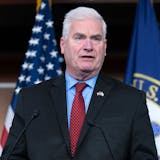Local and state governments across the country face potentially ruinous pension and benefit costs. Too bad so many political leaders have decided that the best way to solve the problem is by making public-sector employees Public Enemy No. 1.
Outgoing Gov. Tim Pawlenty calls them "over-benefited and over-paid." Indiana Gov. Mitch Daniels says they are the "new privileged class." New Jersey Gov. Chris Christie describes two classes of state residents: "Public employees who receive rich benefits, and those who pay for them."
Union leaders are quick to take the bait, trotting out their own mix of dubious statistics and tired clichés about "corporate greed."
Whoever developed the script for taking on public employees must be pleased that so many have their heads buried in it, even as things get worse. One estimate puts the combined total of unfunded state and municipal pension obligations at almost $3.1 trillion. It's an estimate over 30 years and highly dependent on what happens to the stock market in coming decades, but we're not talking about a theoretical problem.
Just ask officials in Illinois, who've resorted to borrowing billions to prop up the state's pension funds. New Jersey skipped a $3.1 billion payment owed to its plans. Prichard, Ala., stopped sending pension checks to 150 former city employees and has filed a Chapter 9 bankruptcy petition. In San Diego, some think bankruptcy may be the only way for California's second-largest city to shed some or most of its $3.5 billion in pension and benefit liabilities.
Pension costs are not threatening to bankrupt any Minnesota cities because most public employees are enrolled in one of three state-run plans. But that's a far cry from saying all is well. The three major state plans are an estimated $12.3 billion short of the cost of benefits that will have to be paid out over the next 30 years. Add another $3 billion to account for unfunded liabilities of independent plans, including the St. Paul Teacher's Retirement Fund. Tack on another $2.5 billion to $3 billion for other benefits that some Minnesota cities and many school districts offer retirees, such as health care.
Pretty soon you're talking about a shortfall of almost $20 billion, and it could get worse if the stock market does as badly in the next 10 years as it has in the most recent decade.
The issue plaguing pensions is the same one facing Social Security: Fewer people are paying into the fund even as the benefit, and number of people relying on it, grows. In 1985 there were four workers for every person drawing a pension from one of Minnesota's three big plans and the average benefit was $5,053. By 2009 there were fewer than two workers for every beneficiary collecting an average of $18,472.

